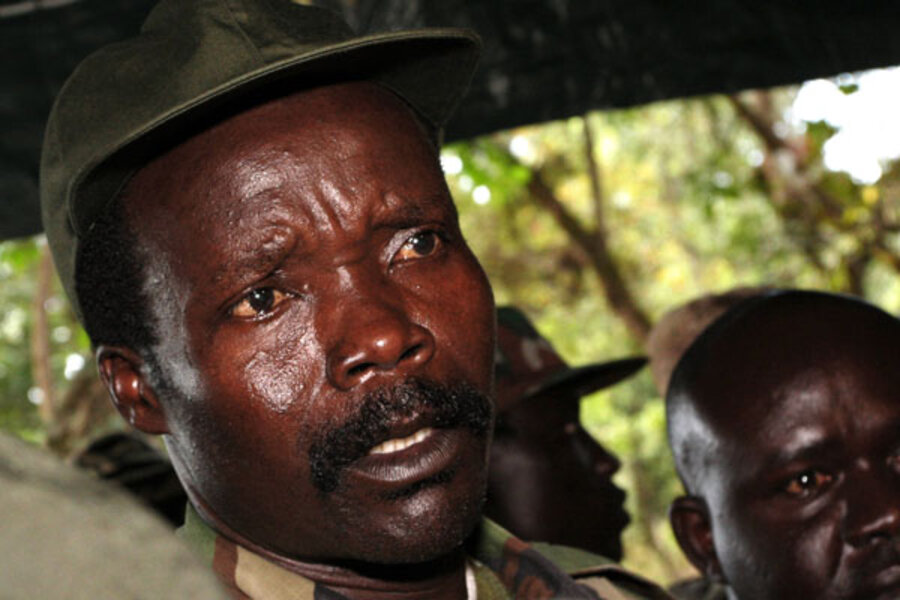Kony 2012: Campaign against African warlord goes viral, now who is he?
Loading...
Who is Joseph Kony? An online campaign aimed at raising awareness about the brutal warlord in Central Africa went viral yesterday, masterfully taking Twitter and Facebook by storm with a heartfelt video but not informing people deeply about the man and his context.
Today the Kony 2012 campaign website is fleshed out with more background material on the history of Kony and his small band of pillagers called the Lord’s Resistance Army (LRA).
The campaign, run by the nonprofit Invisible Children in San Diego, is also raising money for projects aimed at protecting villages and rehabilitating child soldiers in the affected countries of the Democratic Republic of Congo, the Central African Republic, South Sudan, and Uganda.
While the group’s initial goal – to make Joseph Kony infamous – succeeded, it also left many people wanting to know more about this newfound public enemy No. 1. With few links to further information on the Kony 2012 website yesterday, the curious turned to Google for answers. A story the Monitor published back in October on Kony suddenly became one of our most read stories yesterday.
So for those who retweeted the campaign video or bought the Kony 2012 T-shirt but want to know more about the decades-old problem of the LRA, here is a guide to past Monitor coverage.
Fighters with the Lord’s Resistance Army rose up against the Ugandan government in 1987, in a battle that is both one of the longest running and most brutal in the world, according to a Monitor background briefing on the LRA from the Enough Project. The briefing explains the role of religion in the conflict:
Though they are often portrayed as a Christian fundamentalist group bent on establishing a government in Uganda based on the Ten Commandments, religion no longer practically serves as a raison d’être for the LRA; rather it is used selectively to ensure adherence to military discipline and create an environment where commanders are respected and feared…. The rebel group is notorious for murder, torture, mutilation, rape, widespread abductions of children and adults, and pillaging.
Kony is depicted in media reports as a messianic figure. He told the Australian Broadcasting Corporation in 2006 that "very many" spirits spoke to him, telling him things like "You, Mr. Joseph, go and take this thing and that thing." His organization originally rallied to defend the rights of an ethnic group, but lost much support through its thuggery. Starved of recruits, the group turned to abducting children.
Many estimates put the number of children abducted by the LRA at 30,000 or more, many used as porters or sex slaves. The ongoing human rights violations has spurred activism in the West for intervention in the conflict, drawing on some of the activists who tried to stop the Darfur genocide. Activists succeeded in getting President Obama last October to dispatch 100 “combat-equipped US forces” to assist region militaries fighting the LRA.
Specifically, the American troops are tasked with assisting in “the removal from the battlefield” of Joseph Kony and other senior leaders of the Lord’s Resistance Army, or LRA, Obama said in a letter to the leaders of the House and Senate. Although the troops will be equipped for combat, officials specified that their principal role would be advisory.
There are a number of reasons why the US jumped into this fight while staying away from chasing other international outlaws.
Lobbying in Congress for intervention created bipartisan willingness for intervention at a time when members could agree on almost nothing else. The intervention also fit into Obama’s Libya formulation: intervene at a small scale in places where it could tip the balance against further atrocities. And the US military has been interested in getting more involved in Africa, having recently set up a new Africa Command (AFRICOM).
The Monitor has published a number of voices arguing for and against tackling Kony and the LRA through military means. Kellen McClure with Freedom House argued for military intervention:
While it is true that there are a lot of unpleasant people in the world, one would be hard pressed to find any who are more unpleasant than Joseph Kony and can be “dethroned” as easily. Sending military advisers to Central Africa is a small price to pay for ending the career of one of the most horrific mass murderers of the past 20 years.
But even though Kony's fighters number around 200, many of the opponents of sending US forces argue Kony won’t be an easy catch:
Part of the reason Kony has been able to evade capture for so long has to do with the way he positions his fighters around his camps and the systems of notification of impending attack he's able to employ.
That point was echoed by guest blogger Ledio Cakaj:
Even when the US provides satellite images of supposed LRA groups to the Ugandan army on the ground, the information often arrives too late or is difficult to analyze. “All [satellite] images look like the jungle,” a Ugandan army commander told Enough.
History before and after Obama’s decision gives some backing to the skeptics. The international community has tried to corner Kony before, only to see the LRA launch devastating reprisal attacks on civilians in Central Africa. And a half year after Obama’s decision, the LRA is still able to move through the region, raiding villages to steal food and slaves.
The latest attacks have occurred in the last 30 days, with LRA attacks reported in the village of Bagulupa, 35 miles east of Dungu in the eastern region of the Democratic Republic of Congo. The attacks occurred on Feb. 10 and 24, and appear to have been standard raids for food. One person was killed, and 17 villagers abducted, probably for use as porters or sex slaves, according to the Office of the United Nations High Commissioner for Refugees.







